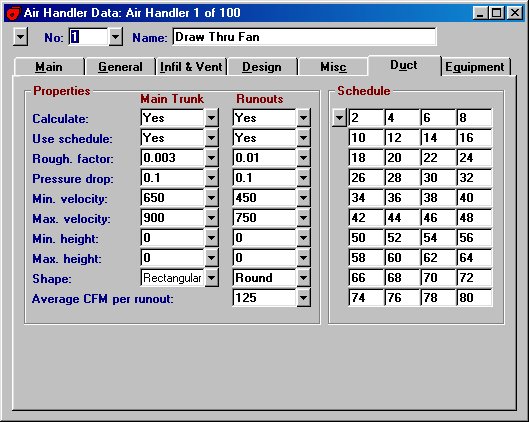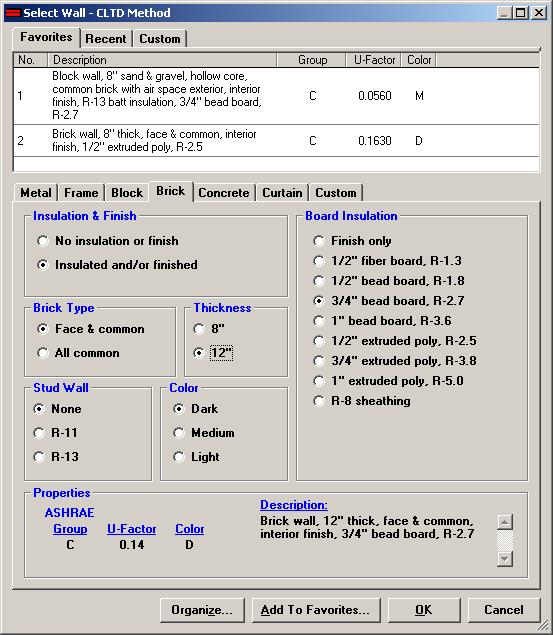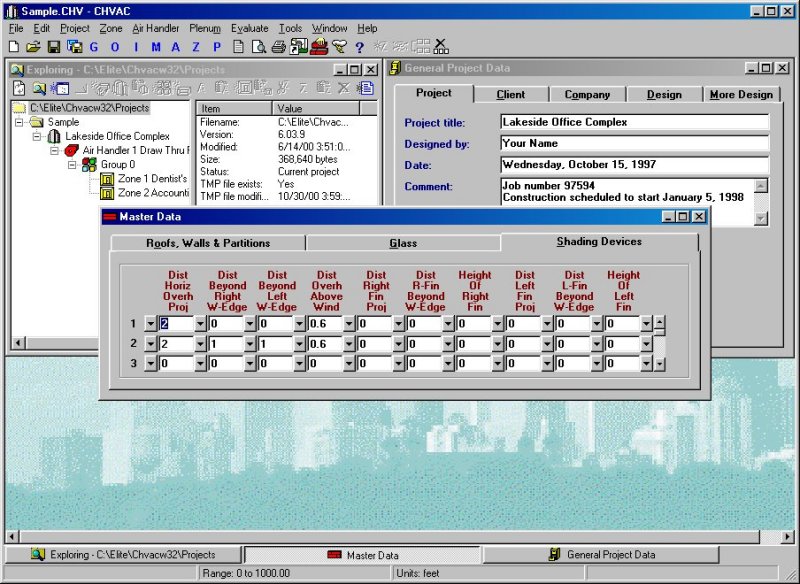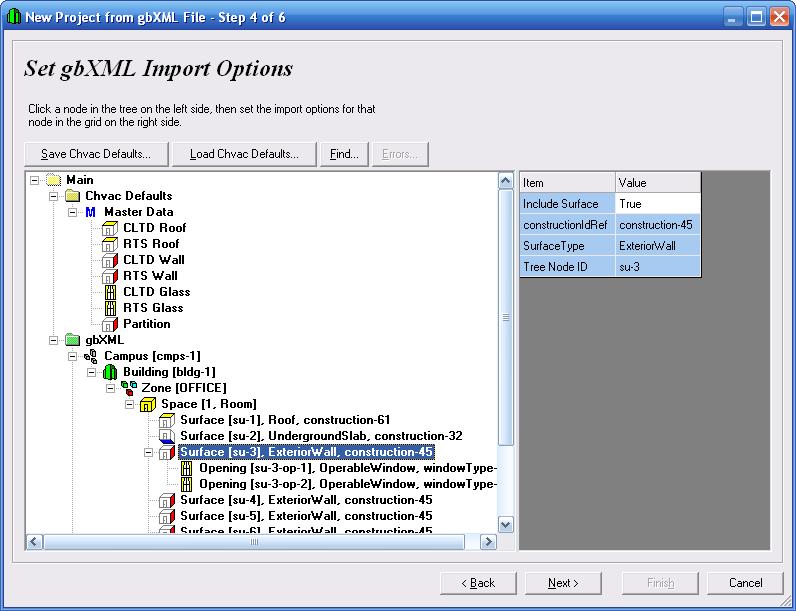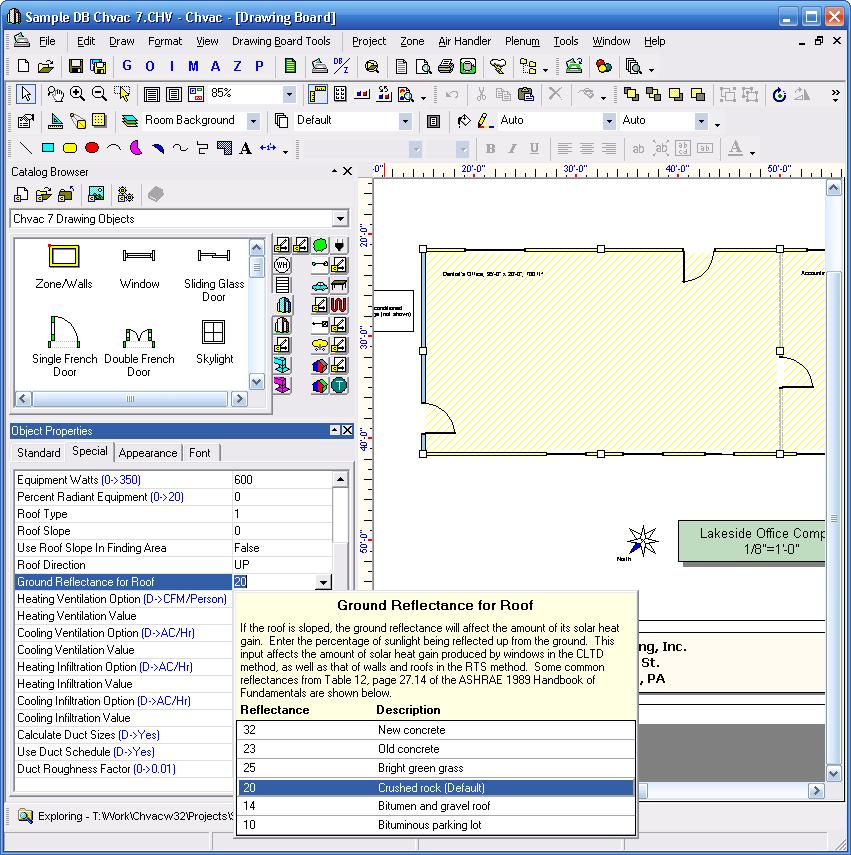Overview
Chvac quickly and accurately calculates the maximum heating and cooling loads for commercial buildings. The cooling loads can be calculated with either the CLTD method or the new RTS (Radiant Time Series) method. The program allows an unlimited number of rooms which can be grouped into as many as 100 air handling systems. Chvac automatically looks up all cooling load and correction factors necessary for computing loads. In addition, it can look up outdoor design weather data for over 2000 cities located around the world. There is also provision for editing the weather data as well as adding data for other cities. Comprehensive reports list the general project data, detailed room loads, air handler summary loads, outside air loads, total building loads, building envelope analysis, tonnage requirements, CFM air quantities, chilled water flow rates (if applicable), and complete psychrometric data with entering and leaving coil conditions. Other outstanding features include ASHRAE Standard 62 analysis, automatic building rotation, 360 degree wall orientations, tilted glass, exterior shading, internal operating load profiles, variable indoor design temperatures, people diversity, pretreated outside air, seasonal infiltration and ventilation rates, reheat loads, duct gains and losses, and return air plenums.
Five Versions Available
There are five versions of the Chvac program; 2 room capacity ($299), 10 room capacity ($399), 50 room capacity ($599), 100 room capacity ($999), and unlimited capacity ($1499). Keep in mind that a room is a single space, and that rooms can be grouped into air handling systems which in turn make up the building. Rooms can optionally be grouped under vav boxes as well (zones). This allows Chvac to compute diversified peak loads at four levels in one run of the program: room, vav box (zone), air system, and total building. The maximum number of air handling systems allowed for any version is the number of rooms allowed or 100, whichever is the lesser. Each Chvac version is exactly the same with the exception of the room capacity and price. However, there is a generous upgrade policy. If at any time you decide to obtain a version of Chvac with greater capacity than the original one you obtained, all that is required is to pay the difference in price between the two versions.
Advanced Features
Chvac contains many, many advanced features. Here are just a few of its capabilities.
- Calculates Peak Heating and Cooling Loads
- Calculates Both Heating & Cooling CFM Requirements
- Calculates Runout and Main Trunk Duct Sizes
- Automates Compliance with ASHRAE Standard 62
- Provides Overall Building Envelope Report
- Creates Spreadsheet File with Calculated Results
- Performs Complete Psychrometric Analysis
- Prints Bar Graphs and Exploded Pie Charts
- Exterior Shading Handles Overhangs, Fins, & Glass Tilt
- Uses Exact ASHRAE RTS or CLTD Procedures
- Built-in Design Weather Data for Hundreds of Cities
- Analyzes Up to 12 Months Per Calculation
- Calculates 24 Hours per Design Day
- Allows Unlimited Number of Rooms per Project
- Rooms May Be Grouped Under 100 Air Handlers
- Rooms May Be Optionally Grouped Under VAV Boxes
- Allows 100 Walls, 100 Windows, and 100 Roofs per Room
- Allows Simultaneous Infiltration and Ventilation
- Allows Different Summer and Winter Air Rates
- Allows Different Indoor Conditions for each Room
- Allows 20 Master Roof Types, 20 Master Wall Types, 20 Master Partition Types, and 50 Master Glass Types
- Provides a User-Defined Library of Custom Materials
- Provides a List of your Favorite Materials
- Allows Up to 10 Internal Operating Load Profiles
- Allows Full 360 Degree Wall and Glass Orientations
- Allows Glass to be titled from 0 to 180 degrees
- Allows for Roof and Wall Color Effects
- Provision for Both VAV and Constant Volume Systems
- Proper Handling of Return Air Plenum Loads
- Accounts for People Diversity in Total Building Load
- Computes Supply Fan Horsepower and Heat Gains
- Accounts for Both Draw-thru and Blow-thru Fans
- Calculates Reheat Requirements if Necessary
- Computes Supply and Return Duct Gains and Losses
- Allows Direct Specification of Supply CFM Quantities
- Allows Specification of Minimum Supply Air Quantities
- Allows Heating Only, Cooling Only, or Both
- Excess Supply Air Can be Handled as Reheat, Reserve Capacity, or by Adjusting the Leaving Coil Conditions
- Leaving Coil Conditions Can be Specified with a Desired Dry Bulb Temperature or a Relative Humidity
- Calculates Chilled and Hot Water Coil Flow Rates
- Allows for Pretreated Outside Air
- Calculates benefits of Heat Recovery Ventilators (HRV) for heating and cooling
- Allows Heating and Cooling Safety Factors
- Lighting & Equipment Watts along with No. of People can be Entered Directly or on a Per Square Foot Basis
- Selects Equipment from the ARI/GAMA Databases
- Creates Custom Sales Proposals
- Creates Spreadsheet Output File
Calculation Method
Chvac performs cooling calculations using either the CLTD method or the new RTS (Radiant Time Series) method. The RTS method is described in the latest edition of the ASHRAE Handbook of Fundamentals, while the CLTD method is from earlier editions of the Handbook. The RTS method is especially accurate because it calculates the delayed effect of radiant heat gains during each of the past 24 hours in determining the current cooling load. That means, for example, that the program gives proper consideration to the effect of an external shading device that shades a window in the morning in a room that peaks in the afternoon. The CLTD method, on the other hand, uses exact table values from the Handbook where possible, which means that you can verify the results by hand. You can actually switch back and forth between RTS and CLTD for any project. All you have to do to switch between the two methods is to enter equivalent Master Data definitions for roofs, walls and glass and then change the Cooling Calculation Method input to the other method.
Program Input
Chvac is very easy to use and includes a specific "dropdown" help window for virtually every input, including a list of choices where appropriate. The program performs extensive checks on the data you enter and alerts you to any problems that it finds, such as a wall having too much window area, or a leaving coil temperature for an air handler outside of the expected range.
Five types of data are requested: general project data, outdoor design data, building material data, air handler data, and specific room data. The general project data includes the project and client name, designer, building opening and closing hours, internal operating load schedules, and any desired safety factors. The outdoor design data includes the summer and winter outdoor design conditions (automatically looked up for you if a city reference is given) and the desired ventilation and infiltration rates. The building material data includes the definition of master building material types for roofs, walls, partitions, glass sections, and exterior shading. A user defined material library is available for saving the data on common material types. The air handler data includes the fan and terminal type, the desired heating and cooling supply air temperatures and data for duct heat gains and losses. The room data includes the room name, floor length and width, number of people, equipment watts, lighting watts, external shading data, and specific roof, wall, partition, floor and glass data.
Program Output
Chvac provides several different types of reports which can be selectively previewed on screen or printed. The reports are: General Project Data, Air Handler Input Data, Room Input Data, Detailed Project Room Loads, Air System Room Summary, Total Building, Air System, and Room Load Profiles, Air System Total Load Summary, Air System Psychrometric Analysis, Psychrometric Chart, Overall Building Envelope Report, Pie Charts, Bar Graphs, and the Total Building Load Summary. Virtually all calculated data can be exported to a comma delimited text file that you can then import into your favorite spreadsheet program such as Excel.
Chvac and HVAC Solution Link
The Chvac load calc program calculates a great deal of the data needed to define a system in the HVAC Solution schematic diagramming program. Traditionally, this data has simply been transferred using a manual entry process. Now, there is an automated process whereby HVAC Solution can import all the relevant Chvac data system by system into the HVAC Solution software such that HVAC schematic diagrams are automatically generated. See a video demo of this process here and view more details on HVAC Solution here.
Links to Other Programs
Chvac not only calculates peak heating and cooling loads, it also aids in selecting HVAC equipment and analyzing building operating costs. Project data from Chvac can be exported to Elite Software's Energy Audit program as well as to the eQUEST program (see more info in this paragraph). In the future, we plan to also provide a link to the Energy Plus program. Export to Energy Audit when you want to analyze residential and light commercial projects, essentially any application which uses unitary HVAC equipment. Export to eQUEST when you want to analyze large commercial projects that require precise modeling of variable loads, equipment, operating schedules, and control schemes. For just selecting unitary HVAC equipment, use the built-in Find HVAC Equipment feature of reading equipment performance databases published by the American Refrigeration Institute (ARI) and the Gas Appliance Manufacturers Association (GAMA).
Import and Export of gbXML Files
Chvac now lets you import gbXML files from CAD drawing software such as AutoCAD MEP and many other programs. We give you extensive control over the import process, including the ability to select which spaces, walls and windows to include in the import (see screenshot below). If you are familiar with the data that CAD programs typically write to gbXML files, you know that material definitions are usually incomplete for purposes of load calculation, since they do not usually include data such as wall U-values or roof ASHRAE numbers. So on the import dialog we let you select the default definitions for each kind of master material in the project.
Using eQUEST with Chvac for LEED Certification
Using the free eQUEST program with Chvac gives you a complete load calculation and energy analysis package. First, you enter your project in Chvac and let it determine your peak loads. Then, you export a ready-to-open eQUEST project file from Chvac. Then you open that project in eQUEST, and enter any additional data you want to enter that is specific to eQUEST. Then eQUEST will let you perform a detailed energy analysis. The eQUEST program can also be used to perform the calculations required for the energy portion of LEED certification, as described in an article in the September 2007 ASHRAE Journal (page 58 and following).
Drawing Board
A functional demo of Drawing Board is built into this version of Chvac. The built-in demo version of Drawing Board allows you to draw and save floor plans of unlimited size, but HVAC calculations can only be made for two rooms of the floor plan.
Update Information
Chvac version 7 users can update to version 8 for a substantial discount off the full purchase price. See the Upgrade Pricing page for more information.
New Features in Version 8
Chvac version 8 can be installed on the same computer as version 7, and will not interfere with version 7 at all. There is no problem in having both version 7 and version 8 on your computer at the same time.
The following new features were added to version 8 that were not in version 7.
- Export to EnergyPro. After opening a project, click "File | Export | Export to EnergyPro." You must have EnergyPro installed for this feature to work. You can download a limited, functional demo of EnergyPro from here. Each applicable master data item now has an EnergyPro Code input, which you can use to map that master item to an EnergyPro material. Click the button beside any EnergyPro Code input and you'll see an EnergyPro Material dialog, which lets you select the mapped material from dropdown lists. There is built-in mapping if you leave an EnergyPro Code input blank, but the user-defined mapping is easy to do, and is of course more precise.
- Multiple items of equipment cooling loads for each room. Click the button beside either the Sensible Equipment or Latent Equipment inputs on the Room Data window and a new Equipment Cooling Loads window will open. This window lets you enter as many items of sensible and/or latent equipment loads for each room as you need, each with its own quantity type, usage factor, operating profile, etc.. Click the button beside the Item Name column and a new Typical Equipment Cooling Loads dialog opens. This dialog is filled with sensible and latent load information for various kinds of equipment listed in various tables in both the 2005 and 2009 ASHRAE Handbook of Fundamentals.
- Multiple items of lighting loads for each room. Click the button beside the Lighting input on the Room Data window and a new Lighting Loads window opens. This window lets you create as many individual lighting load items as you need for each room, each with its own characteristics, such as Space Fraction, Usage Factor, etc.. Click the button beside the Description column and a new Typical Lighting Loads dialog opens, which lets you choose from several lists of lighting items that come from tables in the 2005 and 2009 ASHRAE Handbook of Fundamentals.
- Load Preview window: Click the menu "Project | Load Preview" to open this new window. It's similar to the window with the same name in Rhvac, but this one has over 90 columns of data available. You can choose which columns to make visible. There is a corresponding Print Preview report. The Load Preview Layout dialog lets you choose one set of visible columns for the Load Preview window itself, and another set of columns for the Print Preview version of it.
- Plenum-Room temperature difference automatic adjustment. When you enter a return air plenum you can now specify that you want the program to automatically adjust your entered temperature difference between the rooms and the plenum until it converges on a solution. You can select the maximum number of iterations to perform for each plenum, as well as whether or not to round to the nearest whole number temperature. You can enter project defaults for these settings on the Design tab of the General Project Data window, and you can override them for each plenum on the Plenum Data window.
- Pool latent loads. In each room you can now calculate the latent load due to indoor swimming pools. All you have to do is enter square footage of the water surface, enter the water temperature, select an activity factor, and select an airflow velocity. The program will then calculate a latent load for the swimming pool.
- Sloped Ceiling Area Calculator dialog. This dialog lets you enter dimensions for a room's sloped ceiling, and calculates the resulting area of the ceiling. The area is copied to the roof's Width input, and the number 1 is copied to the Length input.
- Miscellaneous latent gains. On the Air Handler Data window you can now enter miscellaneous supply and return latent equipment loads. Loads can be positive or negative, and can occur on either the supply or return side of the coil.
New Features in Version 7
The following new features were added to version 7 that were not in version 6.
- RTS Calculation Method: You can now select to use either the CLTD method or the new Radiant Time Series (RTS) method for calculating cooling loads. The RTS method is found in the latest ASHRAE Handbook of Fundamentals and is very accurate because it calculates the delayed effect of radiant heat gains during each of the past 24 hours on the current cooling load. You can easily switch back and forth between the two methods simply by entering equivalent master roof, wall and glass data on the Master Data window for both methods.
- Easier and Better Glass Definitions: Now you can enter the width and height dimensions for each window or skylight rather than having to enter them for the master glass and then figure out the correct quantity to enter on the Room Data window. The Room Construction value of Light, Medium or Heavy required for each glass in the CLTD method is now automatically assigned based on the selection you make for the entire room in the new Room Type input.
- Individual Ground Reflectance Values: You can enter a different ground reflectance for each component rather than having only one value for the whole project, which makes the results more accurate because different exposures around a building are likely to have different ground reflectances. Because the RTS method requires this input for roofs and walls, each roof and wall now has a Ground Reflectance input, which makes it so each skylight and window is automatically assigned a ground reflectance value that is appropriate for its exposure.
- Glass Number of Occurrences: You only have to enter data once for a window or skylight that occurs multiple times in the same wall or roof.
- Floor Slab Coefficient for Each Room: You can now enter the floor slab coefficient for each room rather than having to use the same value for the whole project.
- Easier to Use Room Data Window: The Room Data window (formerly "Zone Data") has been redesigned to make it easier to enter all the data. You can change the number of visible roofs, walls and glass by clicking the plus and minus buttons next to each group's scrollbar. Pressing Enter when on the last visible row of a component now makes the components scroll down by one so you can enter another item of the same type. If the Type input of a component is set to zero, pressing Enter moves the cursor to the next group of inputs. All the important data is now on two tabs instead of three.
- More Roofs, Walls and Glass per Room: We've more than doubled the allowed number of roofs, walls and glass you can enter for a room.
- Room Notes: You can save as many notes about a room as you want in the new "Notes About This Room" input on the Room Data window.
- Easier Weather Data Selection: Both the Weather Database and the Indoor/Outdoor Design windows now let you select a city from a single dropdown list that shows all cities in the database.
- Easier Weather Database Editing: It is now much easier to edit and add cities in the redesigned Weather Database window.




